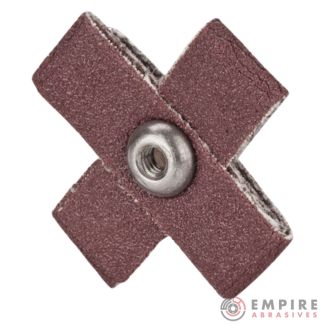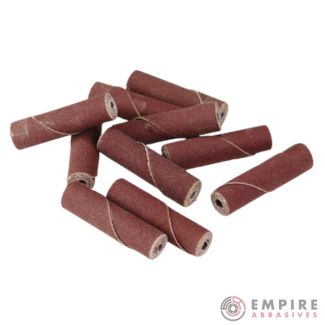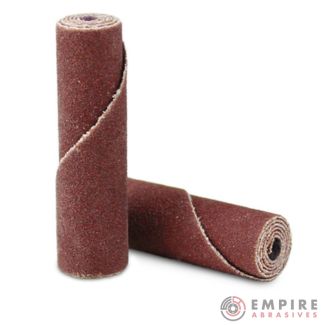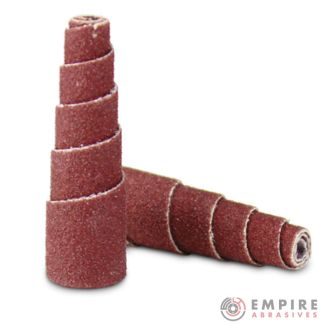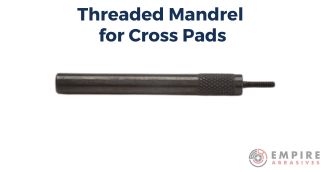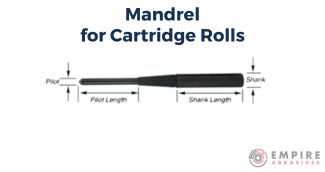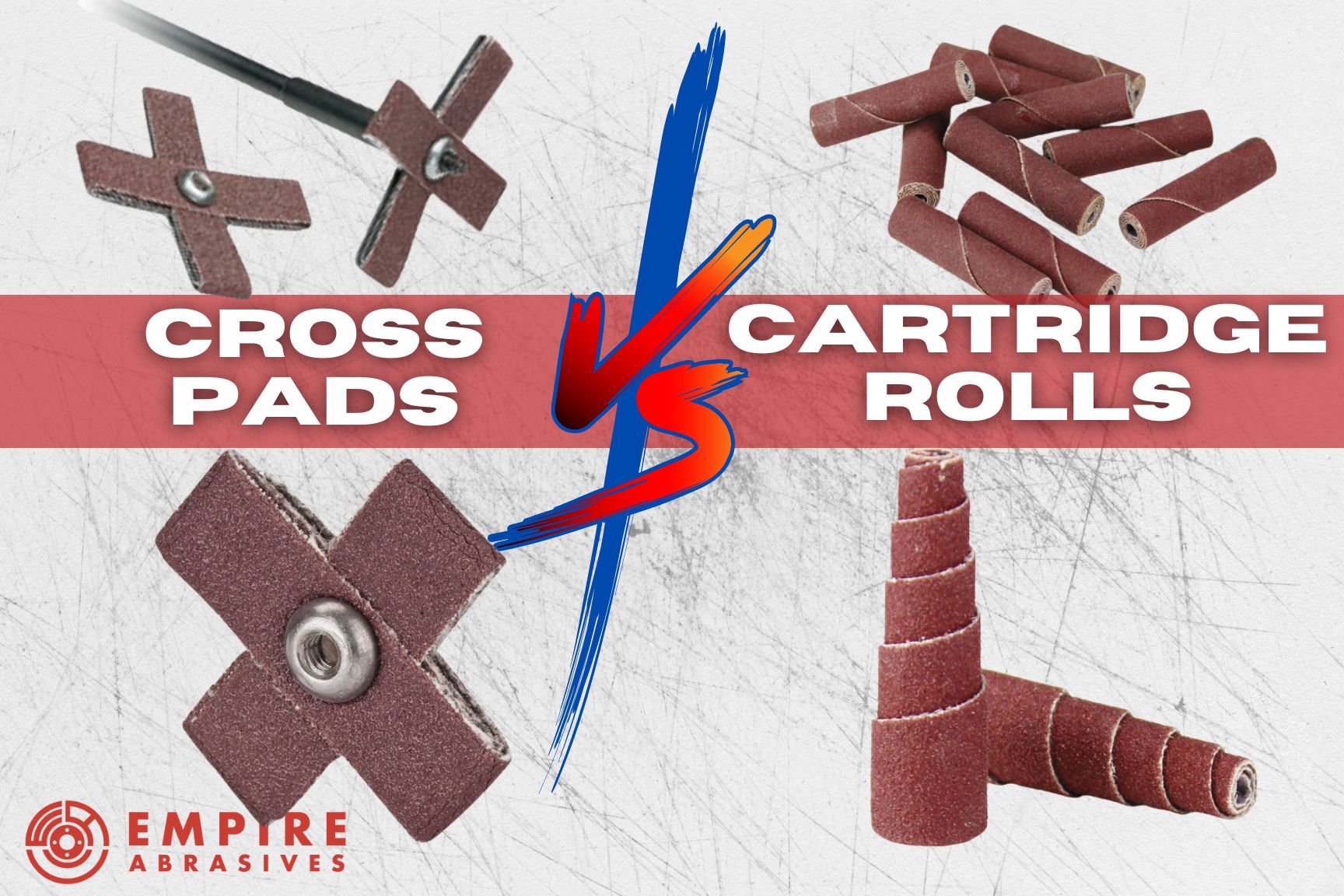
Two abrasive products that customers often aren’t sure about which one they need are cross pads and cartridge rolls. They are both useful for a lot of the same sanding and grinding tasks, but each has their own unique features, so it’s important to choose the right one for your specific job. This article goes over the differences between each, and recommendations for when to use each abrasive.
What are Cross Pads?
Abrasive cross pads are a type of sanding tool that is made up of flexible sandpaper-like abrasive flaps, folded over one another to make a cross shape. They are often used for tasks like grinding, polishing, and sanding inside pipes, tubes, holes, and cylinders.
Their unique shape allows them to conform to the shape that you are sanding. The extra flexibility allows the cross pads to conform to the surface being sanded, making them very useful for sanding in tight, intricate areas.
Cross pads are compatible with a variety of power tools like rotary drills and die grinders easily by attaching them to a threaded cross pad mandrel.
Advantages of Cross Pads
Cross pads offer a number of advantages with their cross sign/t-shape/plus sign structure:
- Able to reach into corners and crevices that other tools can't
- Excellent for detailed work
- Very flexible and can conform to the shape of most workpieces
- Flexibility that is ideal for use on irregular or contoured surfaces
- Easy to use and can be attached to a variety of power tools (with a mandrel attachment)
- Affordably priced
Disadvantages of Cross Pads
There are a few disadvantages though:
- Not as durable as some other types of sanding pads and may need to be replaced often
- Does not perform well when applying firm pressure
- Not suitable for sanding large, flat surfaces
Cross Pad Applications
Common uses for these pads include close-tolerance
- Grinding and polishing metal, wood, plastic, and other materials
- Sanding, grinding, and polishing in tight places like pipes, tubes, holes, and cylinders
- Blending, deburring, grinding and finishing of irregular channels, bell mouth configurations, inside contours, fillets and corners
- Contouring intricate designs and patterns into wood and other soft materials
How to Use Cross Pads Effectively
First choose the appropriate sanding grit. Attach your cross pads to a compatible tool (die grinder or rotary drill). As you grind the surface, apply light pressure, letting the abrasives do the work for you. Too much pressure can cause the pads to deform which could leave you with an uneven finish. Change the pad when it becomes worn or clogged.
What are Cartridge Rolls?
Cartridge rolls are another abrasive tool that is great for reaching into tight areas or irregular surfaces. They are made up of abrasive cloth, rolled up into a cylinder shape. They can either be found as straight cylinders or as a tapered shaped cartridge roll. Sizes can vary, but they are most often found between 1 and 2 inches in length and 1/4 to 1 inch in diameter.
Due to the rolled-up design of the cartridge sanding rolls, the rolls last long and need less stopping time while working. This is because as the outer layer of abrasive material is used up, the sheet tears off, exposing a fresh layer of abrasive until the entire roll is used up.
Advantages of Cartridge Rolls
Cartridge rolls have several advantages:
- Multi-layered design lasts longer than many other abrasive tools, with new abrasives being exposed as used layers tear away
- Easy to use and can be attached to a variety of power tools (with a cartridge roll mandrel attachment)
- Great for precision work on curved or contoured surfaces
- Affordably priced
Disadvantages of Cartridge Rolls
There are a few disadvantages though:
- Not as flexible as tools like cross pads, and may not conform to irregular surfaces
- Not suitable for sanding large, flat surfaces
Cartridge Roll Applications
Cartridge rolls are commonly used for a variety of tasks, including:
- Grinding and polishing metal, wood, plastic, and other materials
- Precision finishing on curved or contoured surfaces
- Sanding, grinding, and polishing in tight places like pipes, tubes, and other small openings
- Deburring and blending edges and seams
- Finishing and polishing inside of pipes, tubes, and cylinders
- Removing flash and parting lines in castings
- Carving intricate designs and patterns into wood and other soft materials
Straight Cartridge Rolls vs. Tapered Cartridge Rolls
Cartridge rolls can be found in two different styles, straight and tapered.
Straight Cartridge Rolls
Straight cartridge rolls have a cylindrical shape with a uniform width from the top to bottom of the roll. These provide consistent sanding throughout their length. They are best suited for smoothing out welds on flat surfaces, general-purpose sanding applications where consistent contact is required, grinding and deburring inside narrow locations, and sanding down holes cut with a hole saw.
Tapered Cartridge Rolls
Tapered rolls are tightly wound in a cone/angle shape. They are sometimes referred to as “sanding cones” because of this shape. Their angled/tapered design allows them to reach into narrower spaces than a straight roll can. Tapered cartridge sanding rolls are often used for applications requiring the most precision and on jobs with irregular contours, fillets, and intricate shapes.
How to Use Cartridge Rolls Effectively
First choose the appropriate grit. Attach your cartridge roll to a compatible tool (die grinder or rotary drill) using a mandrel attachment. As you grind the surface, apply light pressure, letting the abrasives do the work for you. As the outer layer of abrasive wears away, it will tear off to expose a fresh layer meaning you can keep grinding longer. Change the roll when it becomes fully worn or clogged.
Choosing Between Cross Pads and Cartridge Rolls
Both of these abrasive products have similar uses. When deciding whether to use cross pads vs cartridge rolls, there are some factors to consider:
Surface Type
- Curved, Irregular, or Contoured Surfaces: If your project has a curved, irregular, or contoured surface, the cylindrical shape of cartridge rolls would make them a better choice.
- Tight or Intricate Spaces: For projects that require reaching into tight spaces, cross pads would be a better choice. Cartridge rolls are able to get into tight spaces, but are limited to the width of the rolls and since they aren't as flexible as cross pads, there isn’t as much room to maneuver them. Cross pads, on the other hand, are able to fold up and conform to the area you are sanding.
Type of Material
Both of these abrasives are made using aluminum oxide, which is an abrasive grain useful for sanding and grinding most surface materials from hard metals like stainless steel to soft surfaces like wood or fiberglass. However, each of these tools can be better suited for different applications.
- Metal Surfaces: When working with metal surfaces, a cartridge roll will be best when you need to apply extra pressure and do more aggressive grinding.
- Wood or Softer Materials: If you are working with these softer surfaces, cross pads are more flexible and can follow the contours of the material.
Durability & Longevity
- Cartridge Rolls: If you’re taking on a large project and need a tool that has more longevity, you’ll want to use a cartridge roll. The multi-layer design means that they will last longer, without the need to swap it out for a replacement as often.
- Cross Pads: If durability isn’t as important but adaptability to conform to various shapes is, you’ll want a cross pad.
Ease of Attachment/Tool Compatibility
Cross pads and cartridge rolls both are compatible with the same power tools, like rotary drills and die grinders. You’ll want to make sure you have the right mandrel for the specific abrasive you’re using so you can attach your abrasive to your power tool.
Wrapping Things Up
Choosing between cross pads and cartridge rolls ultimately comes down to the specific requirements of your project. Both tools have their unique strengths, each with their own set of applications and limitations. Hopefully this article helped you get a better understanding of the differences of each and which you’d need for your project. If you have any questions or need guidance on selecting the right tools, our abrasive experts at Empire Abrasives are here to help. Reach out to us during regular business hours via phone, chat, or email. And if you're trying to contact us outside of our business hours, don't hesitate to leave a voicemail or send us an email.
If you’ve made your decision on which abrasive you need, check out our product lines below:

